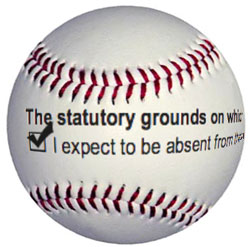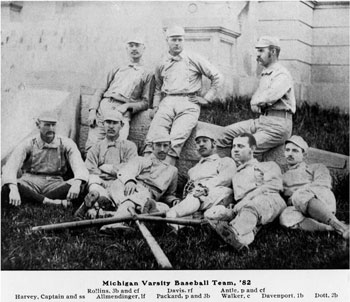Primary elections in Michigan fall on Tuesday, Aug. 3 this year. That’s also the day the Detroit Tigers start a three-game series with the Chicago White Sox at Comerica Park. Here’s a suggestion for Ann Arbor city voters: Don’t plan to go the polls. Instead, plan to take the whole day off and go to the ball game. You can still vote, vote, vote for your home team – you’ll just need do it with an absentee ballot.

Absentee voter applications are not printed on baseballs. This is just someone's execution of the concept that "Every article should have art!"
Now, you don’t have to go to the game in order to qualify for an absentee ballot. But just to be clear, if you do plan to make a whole day event out of your visit to Detroit to watch the game, that will absolutely qualify you for an absentee ballot. If you expect to be out of town, that’s a legally valid reason for voting absentee.
Maybe some of you would even like to make the short drive in to the ballpark after a Monday night stay at the Westin Book Cadillac – from what I understand, it’s a pleasant place to spend the night, even if you’re not a Washtenaw Communty College trustee.
What about you Chronicle readers who aren’t baseball fans? If you want to vote absentee, the current election law specifies a limited set of other reasons you can use, which include being older than 60, being in jail, or having religious beliefs that prevent attending the polls.
The topic came up a bit more than a week ago, when the Ann Arbor city Democrats hosted a forum for candidates contesting the Democratic primaries for Michigan’s 52nd and 53rd district state House seats. Jeff Irwin, who along with Ned Staebler is running for the 53rd District seat, threw out an idea for a tweak in Michigan’s election laws.
Irwin said he’d like to see “on-demand absentee” voting – citizens would be able to obtain an absentee ballot and avoid the lines at the polls for any or no reason at all. It’s not some new screwball idea – it’s been around a while and enjoys a lot of support, from Washtenaw County clerk Larry Kestenbaum, among others.
For the time being, though, the application for an absentee ballot requires that voters commit, you know, really commit – just like the guy on the mound has to commit to delivering the ball to the plate after starting in that direction – to at least one of the allowable reasons under the state statute. Through June 17, according to the first Absent Voter report sent out last week via email by the city clerk, over 1,800 Ann Arborites have already committed to one of those reasons. [Full Story]










